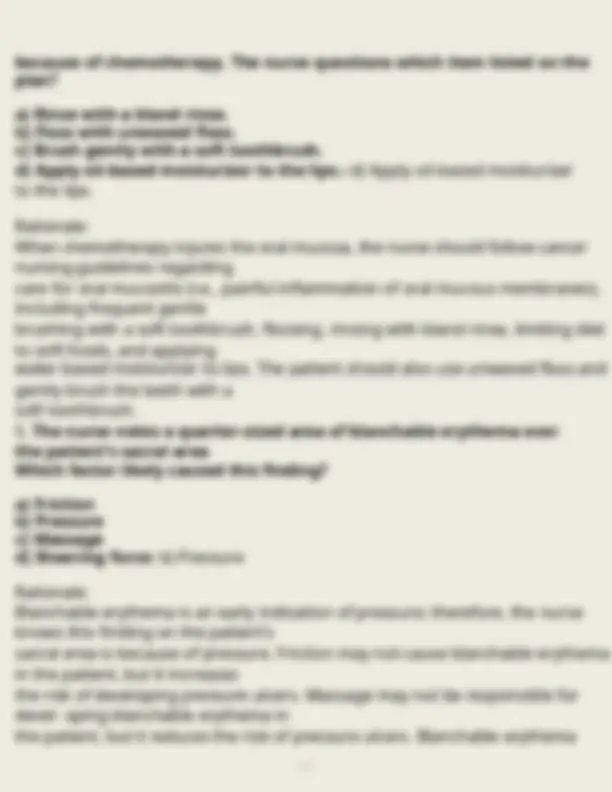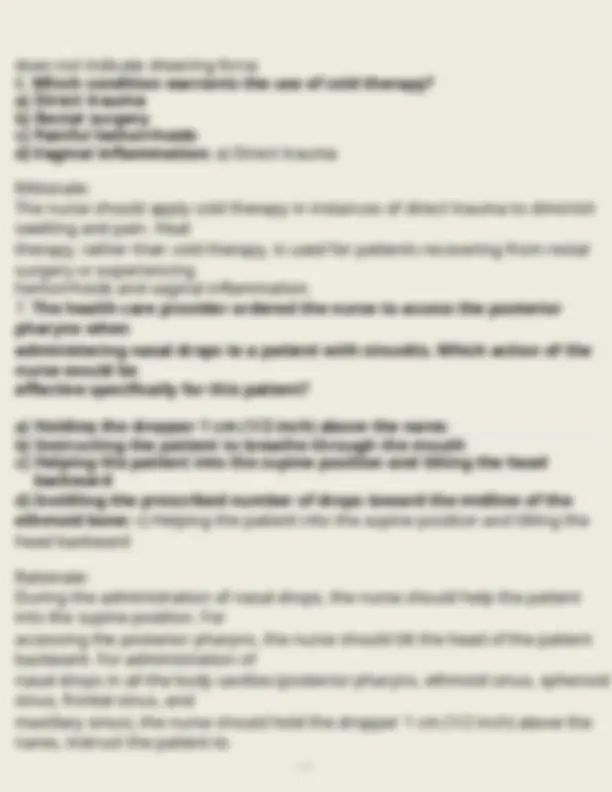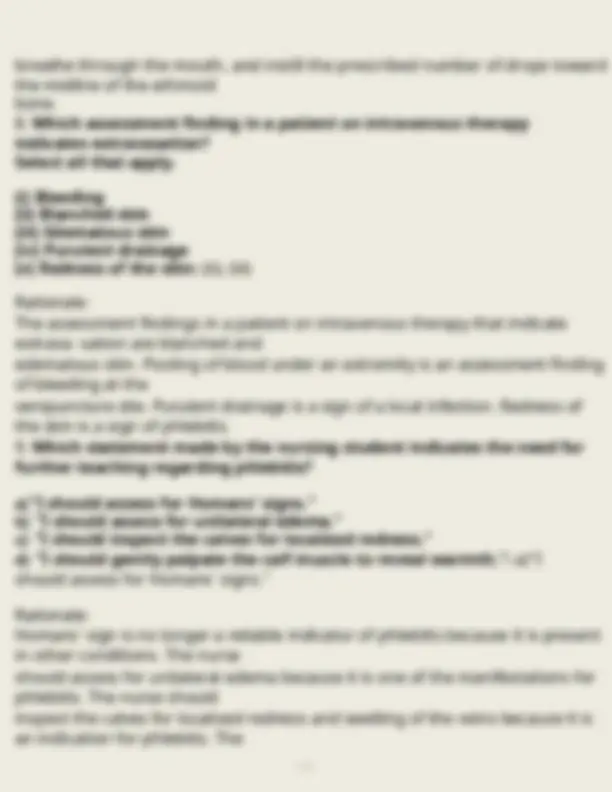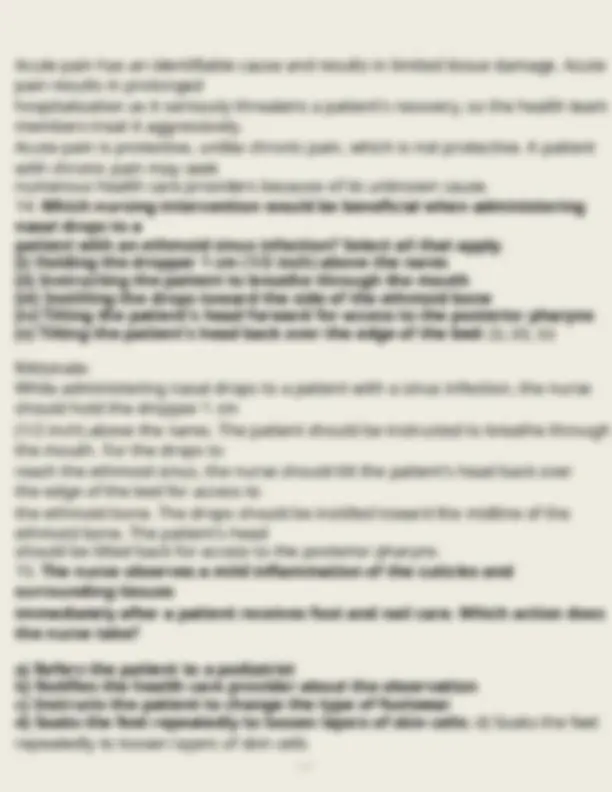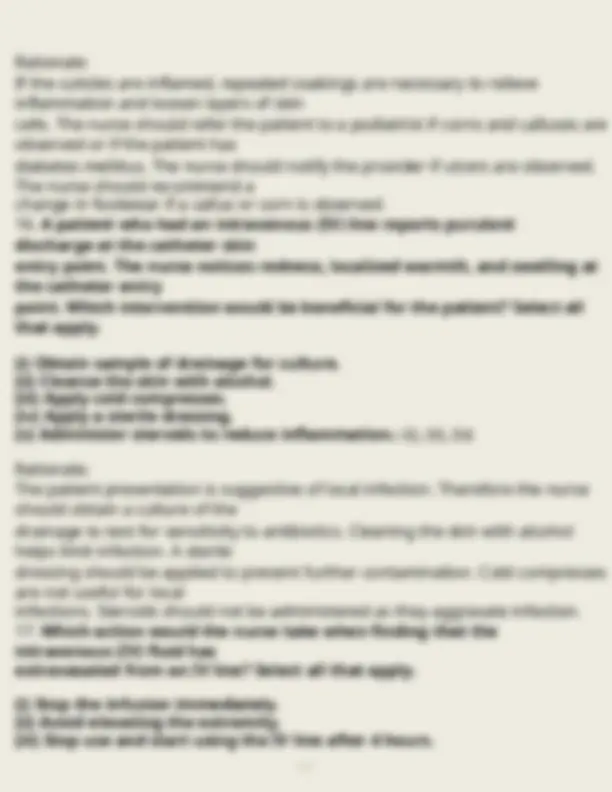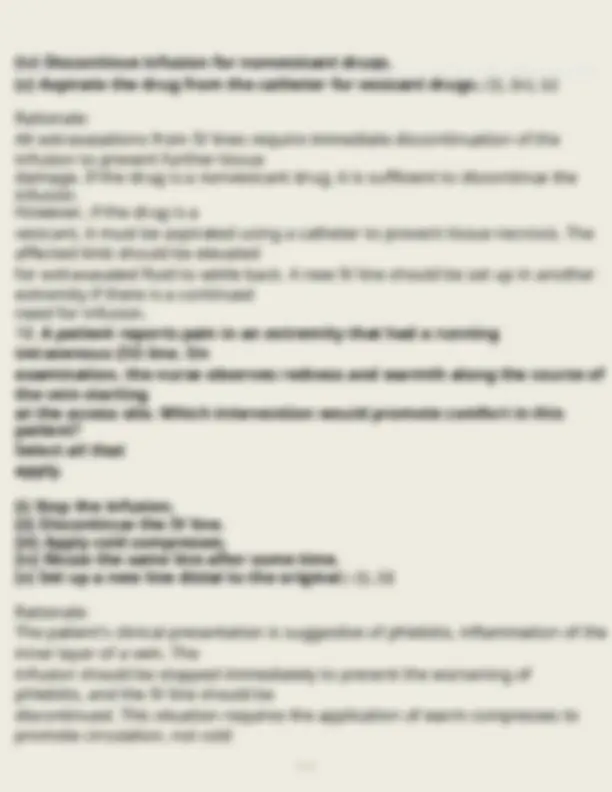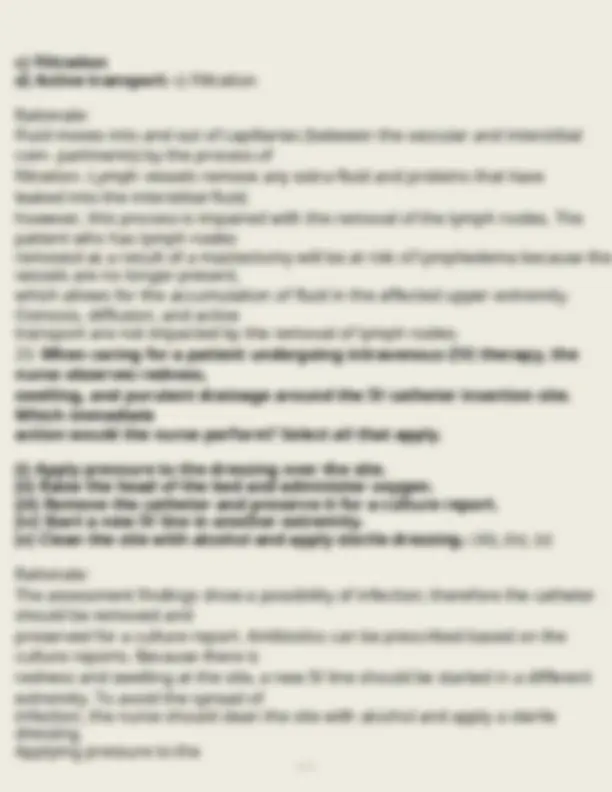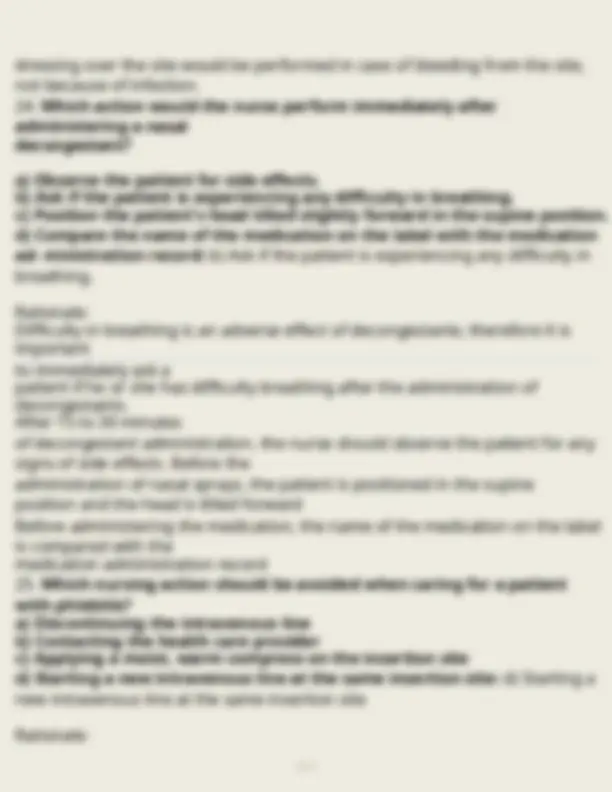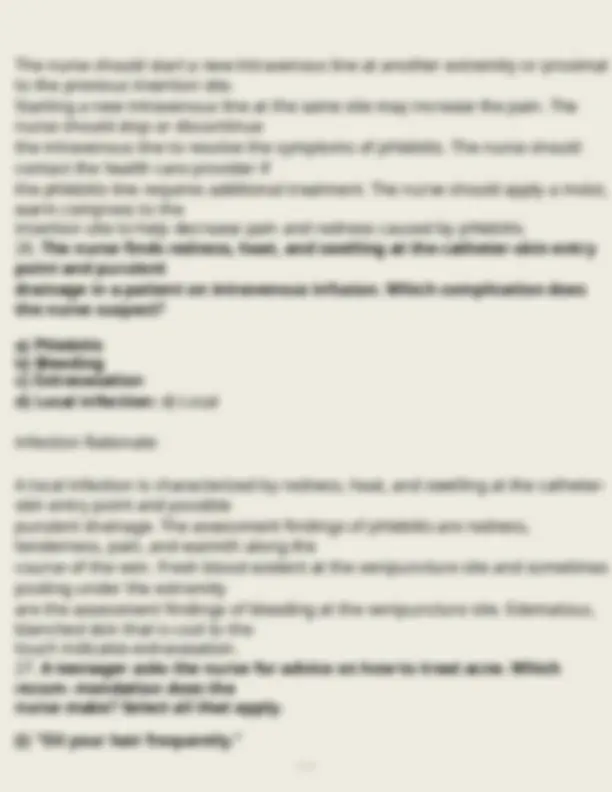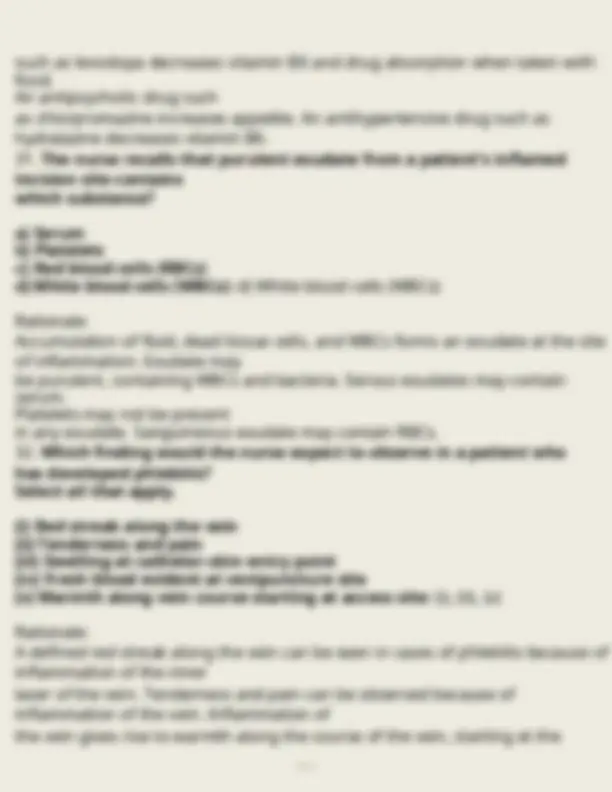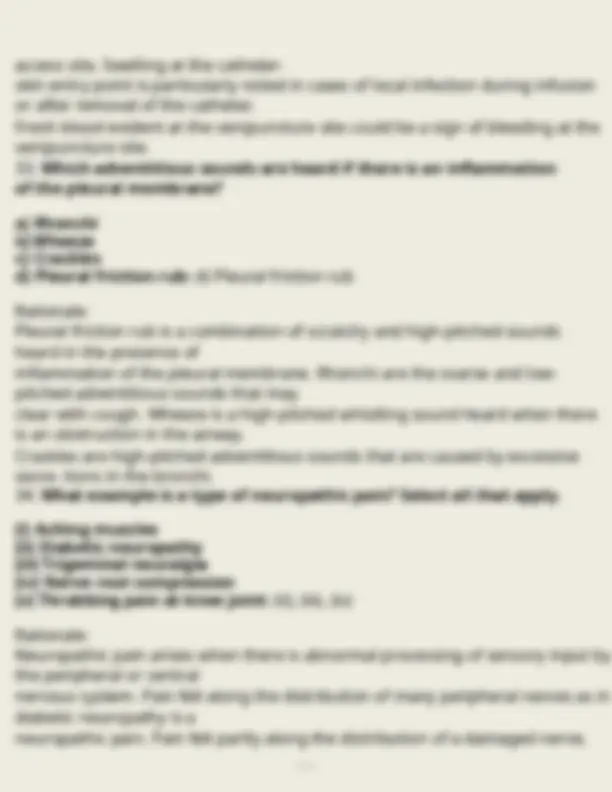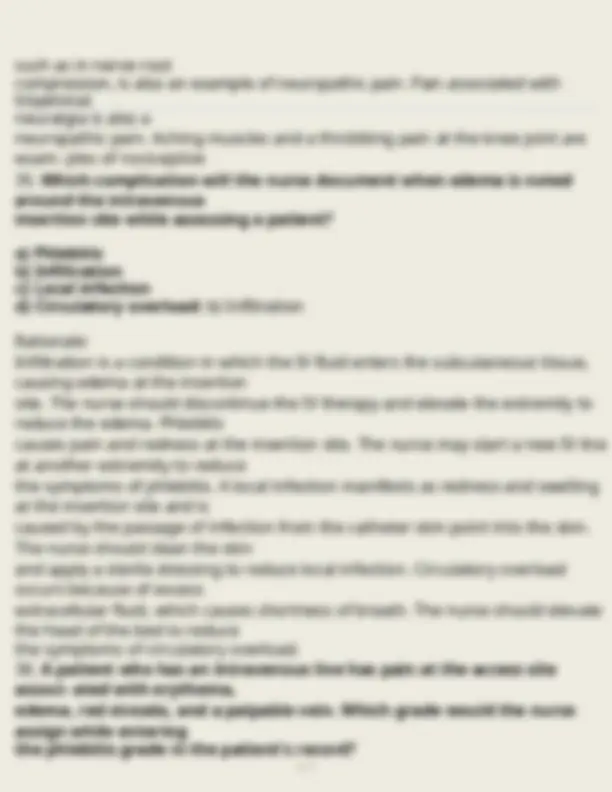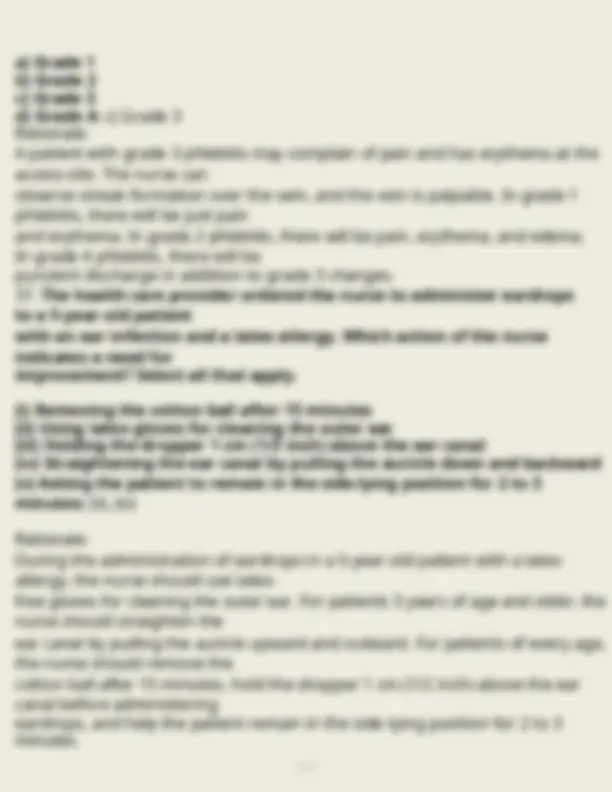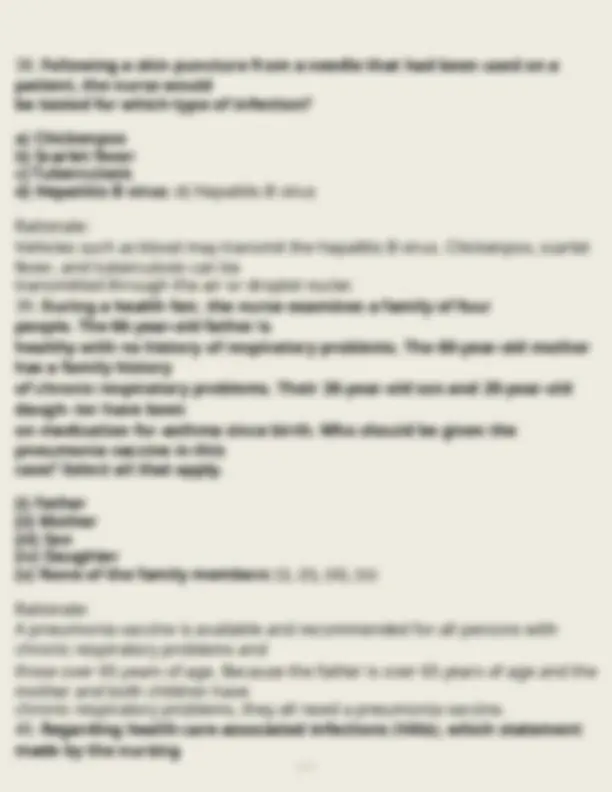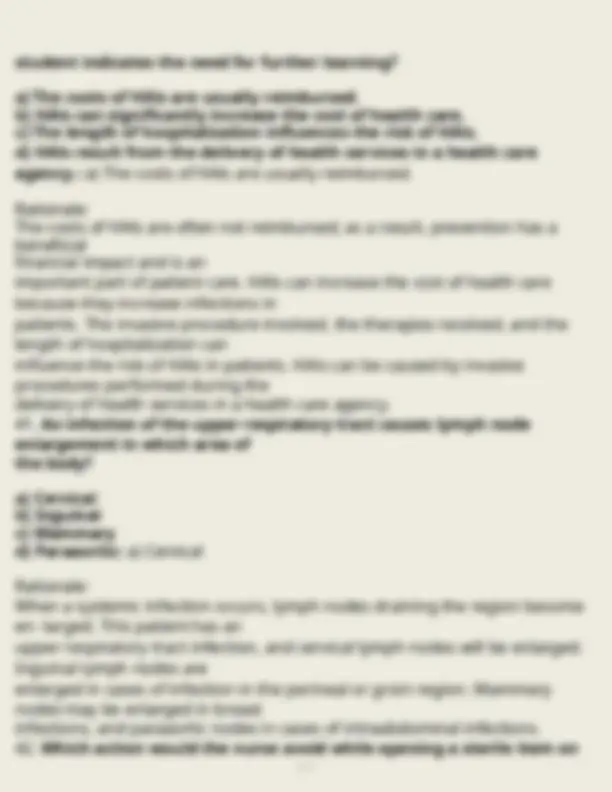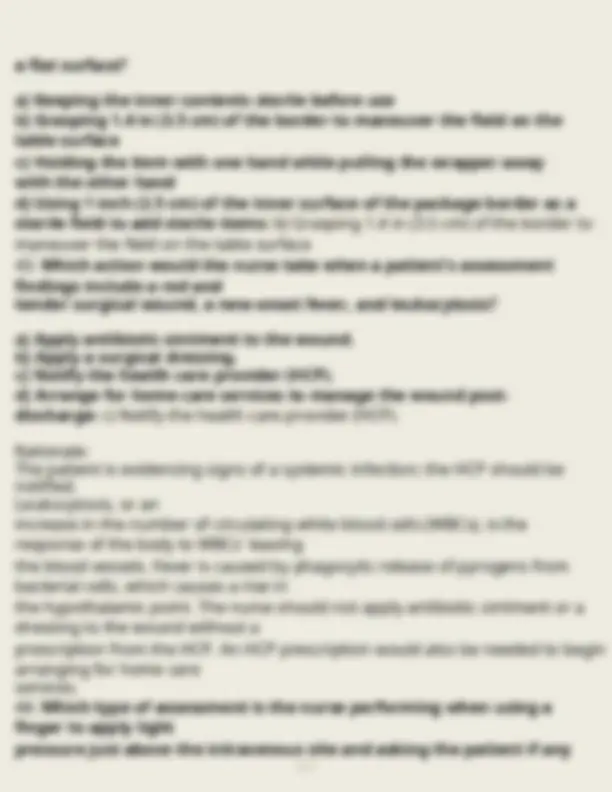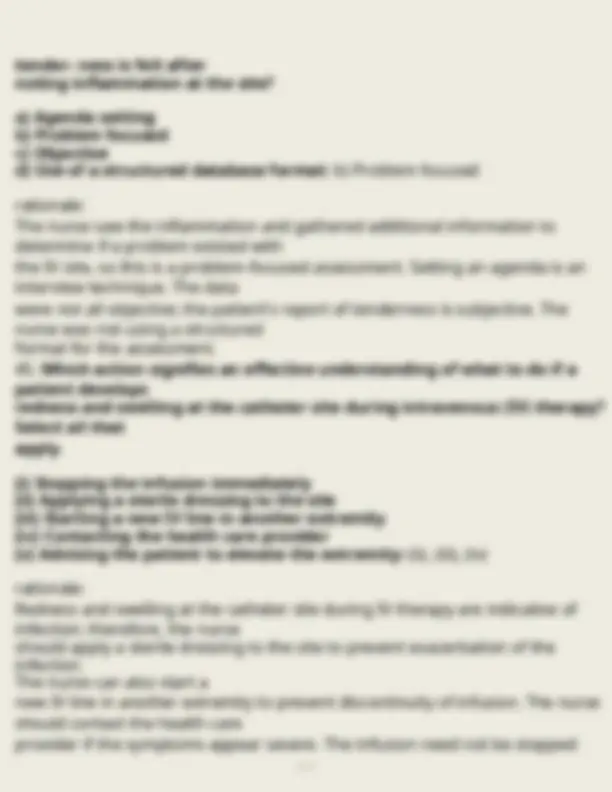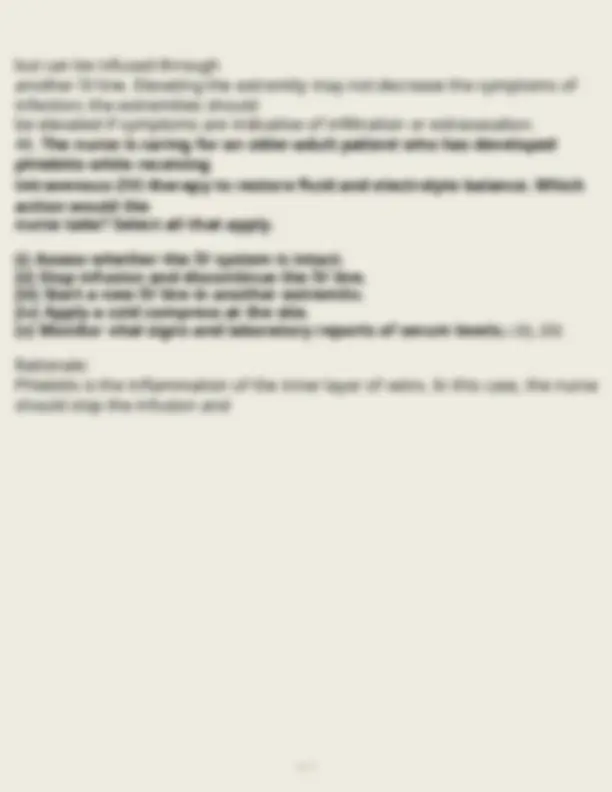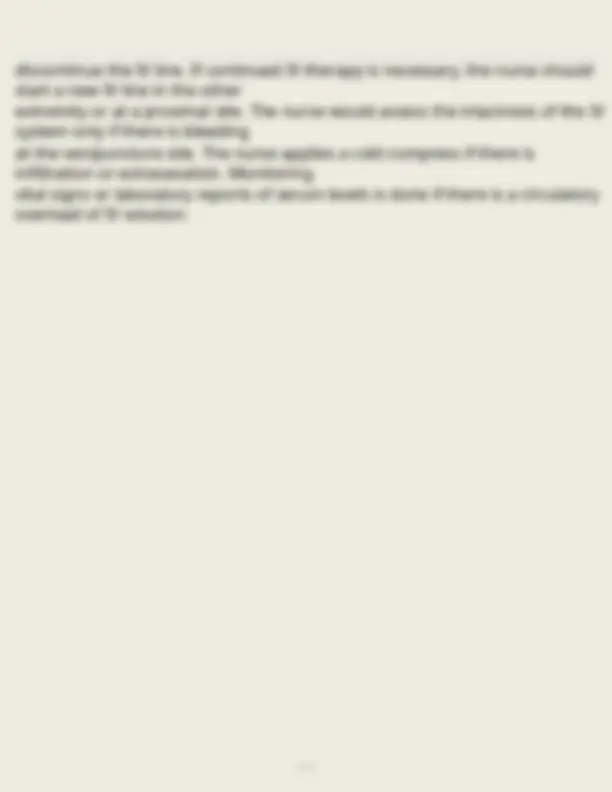Download HESI CONCEPT- Inflammation practice exam questions with accurate answers and more Exams Nursing in PDF only on Docsity!
HESI CONCEPT- Inflammation practice exam
questions with accurate answers
- While performing foot and nail care, the nurse observes tissue edema on the patient's feet. Which predisposing condition might have contributed to the assessment finding? Select all that apply. (i) Stroke (ii) Heart failure (iii) Renal disease (iv) Diabetes mellitus (v) Peripheral vascular disease: (ii), (iii) Rationale: Heart failure and renal disease increase the risk of tissue edema, particularly in dependent areas such as the feet. Cerebrovascular accidents, such as a stroke, cause leg weakness or paralysis. This may result in altered walking patterns, which causes increased friction and pressure on the feet. Periph- eral vascular disease associated with diabetes mellitus causes reduced blood flow to peripheral tissues.
- For which potential complication would the nurse be vigilant while assess- ing the patient who has an intravenous line for fluid therapy? Select all that apply. (i) Pallor (ii) Bleeding (iii) Phlebitis (iv) Infection
(v) Jaundice: (ii), (iii), (iv) Rationale: Bleeding at the venipuncture site is a potential complication of intravenous therapy, which can be noted as oozing or slow seepage of blood at the site. Phlebitis, which is characterized by tenderness, pain, or burning is an inflammation of the inner layer of a vein. Infection is a potential complication of intravenous therapy if aseptic measures were not taken during the procedure. Pallor is not a potential complication of intravenous therapy and can occur in other conditions such as reduced hemoglobin. Jaundice, characterized by yellowish discoloration of skin, is not a potential complication of intravenous therapy and can occur in other conditions such as hepatitis.
- Which statement about elastic bandage application indicates a need for correction? a) "Assess the skin distal to the bandage." b) "Inspect the area for edema and discoloration." c) "Do not apply a bandage if there is an open wound." d) "Assess the condition of the underlying dressing.: c) "Do not apply a bandage if there is an open wound." Rationale: As long as an underlying dressing is on the open wound, it is appropriate to apply a bandage over it. The other statements are correct. The nurse should assess the skin distal to the bandage to check for any swelling or numbness as well as the affected area for edema or discoloration. The dressing should be examined before the bandage is applied so the nurse can first change any soiled dressings.
- The nurse reviews the plan for oral care for a patient who is at a risk of oral mucositis
does not indicate sheering force.
- Which condition warrants the use of cold therapy? a) Direct trauma b) Rectal surgery c) Painful hemorrhoids d) Vaginal inflammation: a) Direct trauma RAtionale: The nurse should apply cold therapy in instances of direct trauma to diminish swelling and pain. Heat therapy, rather than cold therapy, is used for patients recovering from rectal surgery or experiencing hemorrhoids and vaginal inflammation.
- The health care provider ordered the nurse to access the posterior pharynx when administering nasal drops to a patient with sinusitis. Which action of the nurse would be effective specifically for this patient? a) Holding the dropper 1 cm (1/2 inch) above the nares b) Instructing the patient to breathe through the mouth c) Helping the patient into the supine position and tilting the head backward d) Instilling the prescribed number of drops toward the midline of the ethmoid bone: c) Helping the patient into the supine position and tilting the head backward Rationale: During the administration of nasal drops, the nurse should help the patient into the supine position. For accessing the posterior pharynx, the nurse should tilt the head of the patient backward. For administration of nasal drops in all the body cavities (posterior pharynx, ethmoid sinus, sphenoid sinus, frontal sinus, and maxillary sinus), the nurse should hold the dropper 1 cm (1/2 inch) above the nares, instruct the patient to
breathe through the mouth, and instill the prescribed number of drops toward the midline of the ethmoid bone.
- Which assessment finding in a patient on intravenous therapy indicates extravasation? Select all that apply. (i) Bleeding (ii) Blanched skin (iii) Edematous skin (iv) Purulent drainage (v) Redness of the skin: (ii), (iii) Rationale: The assessment findings in a patient on intravenous therapy that indicate extrava- sation are blanched and edematous skin. Pooling of blood under an extremity is an assessment finding of bleeding at the venipuncture site. Purulent drainage is a sign of a local infection. Redness of the skin is a sign of phlebitis.
- Which statement made by the nursing student indicates the need for further teaching regarding phlebitis? a)"I should assess for Homans' signs." b) "I should assess for unilateral edema." c) "I should inspect the calves for localized redness." d) "I should gently palpate the calf muscle to reveal warmth.": a)"I should assess for Homans' signs." Rationale: Homans' sign is no longer a reliable indicator of phlebitis because it is present in other conditions. The nurse should assess for unilateral edema because it is one of the manifestations for phlebitis. The nurse should inspect the calves for localized redness and swelling of the veins because it is an indication for phlebitis. The
the site indicates the need to change the dressing immediately. Transparent dressing should not be removed to assess the infiltration. The presence of moisture at the site indicates a risk of contamination and microbial growth.
- For a patient who has a muscle sprain, localized hemorrhage, or hematoma, which wound care product helps prevent edema formation, control bleeding, and anes- thetize the body part? a) Binder b) Ice bag c) Elastic bandage d) Absorptive diaper: b) Ice bag Rationale: An ice bag helps constrict excess fluid in tissues, which prevents edema. The blood vessels become constricted, help control bleeding, and can decrease pain where the ice bag is placed. Binders are usually placed around the abdomen to make movement less painful and to provide support. Elastic bandages promote hemostasis and will not help anesthetize the body part. An absorptive diaper is not appropriate in this situation.
- Which statement is true about acute pain? Select all that apply. (i) Acute pain is not protective. (ii) Acute pain has an identifiable cause. (iii) Acute pain causes limited tissue damage. (iv) Acute pain results in prolonged hospitalization. (v) Patients with acute pain seek numerous health care providers.: (ii), (iii), (iv) Rationale:
Acute pain has an identifiable cause and results in limited tissue damage. Acute pain results in prolonged hospitalization as it seriously threatens a patient's recovery, so the health team members treat it aggressively. Acute pain is protective, unlike chronic pain, which is not protective. A patient with chronic pain may seek numerous health care providers because of its unknown cause.
- Which nursing intervention would be beneficial when administering nasal drops to a patient with an ethmoid sinus infection? Select all that apply. (i) Holding the dropper 1 cm (1/2 inch) above the nares (ii) Instructing the patient to breathe through the mouth (iii) Instilling the drops toward the side of the ethmoid bone (iv) Tilting the patient's head forward for access to the posterior pharynx (v) Tilting the patient's head back over the edge of the bed: (i), (ii), (v) RAtionale: While administering nasal drops to a patient with a sinus infection, the nurse should hold the dropper 1 cm (1/2 inch) above the nares. The patient should be instructed to breathe through the mouth. For the drops to reach the ethmoid sinus, the nurse should tilt the patient's head back over the edge of the bed for access to the ethmoid bone. The drops should be instilled toward the midline of the ethmoid bone. The patient's head should be tilted back for access to the posterior pharynx.
- The nurse observes a mild inflammation of the cuticles and surrounding tissues immediately after a patient receives foot and nail care. Which action does the nurse take? a) Refers the patient to a podiatrist b) Notifies the health care provider about the observation c) Instructs the patient to change the type of footwear d) Soaks the feet repeatedly to loosen layers of skin cells: d) Soaks the feet repeatedly to loosen layers of skin cells
(iv) Discontinue infusion for nonvesicant drugs. (v) Aspirate the drug from the catheter for vesicant drugs.: (i), (iv), (v) Rationale: All extravasations from IV lines require immediate discontinuation of the infusion to prevent further tissue damage. If the drug is a nonvesicant drug, it is sufficient to discontinue the infusion. However, if the drug is a vesicant, it must be aspirated using a catheter to prevent tissue necrosis. The affected limb should be elevated for extravasated fluid to settle back. A new IV line should be set up in another extremity if there is a continued need for infusion.
- A patient reports pain in an extremity that had a running intravenous (IV) line. On examination, the nurse observes redness and warmth along the course of the vein starting at the access site. Which intervention would promote comfort in this patient? Select all that apply. (i) Stop the infusion. (ii) Discontinue the IV line. (iii) Apply cold compresses. (iv) Reuse the same line after some time. (v) Set up a new line distal to the original.: (i), (ii) Rationale: The patient's clinical presentation is suggestive of phlebitis, inflammation of the inner layer of a vein. The infusion should be stopped immediately to prevent the worsening of phlebitis, and the IV line should be discontinued. This situation requires the application of warm compresses to promote circulation, not cold
compresses. The same line should not be reused; however, if there is a continued need for a line, a new line must be set up in another extremity. Alternatively, a new line may be set up in the same extremity proximal to the present line.
- While assessing a patient, the nurse observes raised, irregularly shaped skin eruptions with red margins. Which mild allergic reaction does the nurse document in the medical record? a) Rash b) Hives c) Rhinitis d) Pruritus: b) Hives Rationale: Hives, or urticaria, is a mild allergic reaction characterized by raised, irregularly shaped skin eruptions with red margins. A rash is a mild allergic reaction that is characterized by small, raised vesicles that are usually reddened all over the body. Inflammation of the mucous membrane lining the nose mucosa is referred to as rhinitis. Pruritus is a mild allergic reaction that involves itching of the skin that accompanies rashes.
- A patient tells the nurse, "I experience a constant dull headache when there is a change of seasons." To evaluate the patient's condition, which action does the nurse take? Select all that apply. (i) Palpate the frontal sinus. (ii) Perform transillumination of the sinuses. (iii) Apply pressure to both eyes. (iv) Exert pressure above the ears bilaterally. (v) Perform internal palpation of the maxillary facial area: (i) Rationale;
c) Filtration d) Active transport: c) Filtration Rationale: Fluid moves into and out of capillaries (between the vascular and interstitial com- partments) by the process of filtration. Lymph vessels remove any extra fluid and proteins that have leaked into the interstitial fluid; however, this process is impaired with the removal of the lymph nodes. The patient who has lymph nodes removed as a result of a mastectomy will be at risk of lymphedema because the vessels are no longer present, which allows for the accumulation of fluid in the affected upper extremity. Osmosis, diffusion, and active transport are not impacted by the removal of lymph nodes.
- When caring for a patient undergoing intravenous (IV) therapy, the nurse observes redness, swelling, and purulent drainage around the IV catheter insertion site. Which immediate action would the nurse perform? Select all that apply. (i) Apply pressure to the dressing over the site. (ii) Raise the head of the bed and administer oxygen. (iii) Remove the catheter and preserve it for a culture report. (iv) Start a new IV line in another extremity. (v) Clean the site with alcohol and apply sterile dressing.: (iii), (iv), (v) Rationale: The assessment findings show a possibility of infection; therefore the catheter should be removed and preserved for a culture report. Antibiotics can be prescribed based on the culture reports. Because there is redness and swelling at the site, a new IV line should be started in a different extremity. To avoid the spread of infection, the nurse should clean the site with alcohol and apply a sterile dressing. Applying pressure to the
dressing over the site would be performed in case of bleeding from the site, not because of infection.
- Which action would the nurse perform immediately after administering a nasal decongestant? a) Observe the patient for side effects. b) Ask if the patient is experiencing any difficulty in breathing. c) Position the patient's head tilted slightly forward in the supine position. d) Compare the name of the medication on the label with the medication ad- ministration record: b) Ask if the patient is experiencing any difficulty in breathing. Rationale: Difficulty in breathing is an adverse effect of decongestants; therefore it is important to immediately ask a patient if he or she has difficulty breathing after the administration of decongestants. After 15 to 30 minutes of decongestant administration, the nurse should observe the patient for any signs of side effects. Before the administration of nasal sprays, the patient is positioned in the supine position and the head is tilted forward Before administering the medication, the name of the medication on the label is compared with the medication administration record
- Which nursing action should be avoided when caring for a patient with phlebitis? a) Discontinuing the intravenous line b) Contacting the health care provider c) Applying a moist, warm compress on the insertion site d) Starting a new intravenous line at the same insertion site: d) Starting a new intravenous line at the same insertion site Rationale:
(ii) "Topical antibiotics may be prescribed for severe forms of acne." (iii) "Use a good soap to wash your face." (iv) "Wash skin and hair thoroughly with warm water." (v) "Use cosmetics sparingly.": (ii), (iii), (iv), (v) Rationale; Acne is an inflammatory condition of the sebaceous glands. Excessive oil makes the skin more prone to develop acne. Topical antibiotics may be needed for severe forms of acne. The skin and hair should be washed regularly with warm water and a good soap to prevent accumulation of dirt or oil in the skin. The patient should use cosmetics sparingly; oily cosmetics or creams accumulate in pores and make the condition worse. Excessive oiling of hair and using oil-based cosmetics may lead to acne formation.
- Which action of the nurse shows efficient skill in administering nasal spray in a patient with bronchial tree inflammation? Select all that apply. (i) Holding the spray 1 cm (1/2 inch) above the nares Asking the patient to spray the medication while inhaling Asking the patient to turn toward the side to be treated Helping the patient into the supine position and tilting the head backward Instructing the patient to hold the breath for a few seconds after taking the nozzle out of the nose: (ii) (v) Rationale; The nurse should ask the patient to spray the medication while inhaling so that more of the drug will reach the target site. The nurse should instruct the patient to hold the breath for a few seconds after removing the nozzle from the nose so that more of the drug reaches the target site. The nasal spray is not sprayed from 1 cm (1/2 inch) above the nares. The nozzle spray should be placed in
appropriate nares, pointing the nozzle to the side and away from the center of the nose. The patient should be placed in the supine position with the head bending slightly forward during the administration of nasal spray. During the administration of eardrops, the nurse should ask the patient to turn toward the side to be treated. During the administration of nasal drops, the nurse should help the patient into the supine position and tilt the head backward.
- The nurse applies an elastic bandage to a patient who has a sprained ankle. Which purpose would the bandage serve? Select all that apply. (i) Reduces edema (ii) Prevents infection (iii) Provides support (iv) Supports stretching (v) Provides immobilization: (i), (iii), (v) Rationale: An elastic bandage on a sprained ankle will reduce edema, provide support, and provide immobilization. The bandage will not prevent infection, and this is not a concern for a sprain unless open wounds are also present. Because the elastic bandage helps immobilize the ankle, it prevents stretching.
- Which classification of drug promotes gluconeogenesis of protein? a) Antiparkinson b) Antipsychotic c) Antihypertensive d) Antiinflammatory: d) Antiinflammatory Rationale: Antiinflammatory drugs such as steroids help promote gluconeogenesis of protein. An antiparkinson drug
access site. Swelling at the catheter- skin entry point is particularly noted in cases of local infection during infusion or after removal of the catheter. Fresh blood evident at the venipuncture site could be a sign of bleeding at the venipuncture site.
- Which adventitious sounds are heard if there is an inflammation of the pleural membrane? a) Rhonchi b) Wheeze c) Crackles d) Pleural friction rub: d) Pleural friction rub Rationale: Pleural friction rub is a combination of scratchy and high-pitched sounds heard in the presence of inflammation of the pleural membrane. Rhonchi are the coarse and low- pitched adventitious sounds that may clear with cough. Wheeze is a high-pitched whistling sound heard when there is an obstruction in the airway. Crackles are high-pitched adventitious sounds that are caused by excessive secre- tions in the bronchi.
- What example is a type of neuropathic pain? Select all that apply. (i) Aching muscles (ii) Diabetic neuropathy (iii) Trigeminal neuralgia (iv) Nerve root compression (v) Throbbing pain at knee joint: (ii), (iii), (iv) Rationale: Neuropathic pain arises when there is abnormal processing of sensory input by the peripheral or central nervous system. Pain felt along the distribution of many peripheral nerves as in diabetic neuropathy is a neuropathic pain. Pain felt partly along the distribution of a damaged nerve,
such as in nerve root compression, is also an example of neuropathic pain. Pain associated with trigeminal neuralgia is also a neuropathic pain. Aching muscles and a throbbing pain at the knee joint are exam- ples of nociceptive
- Which complication will the nurse document when edema is noted around the intravenous insertion site while assessing a patient? a) Phlebitis b) Infiltration c) Local infection d) Circulatory overload: b) Infiltration Rationale: Infiltration is a condition in which the IV fluid enters the subcutaneous tissue, causing edema at the insertion site. The nurse should discontinue the IV therapy and elevate the extremity to reduce the edema. Phlebitis causes pain and redness at the insertion site. The nurse may start a new IV line at another extremity to reduce the symptoms of phlebitis. A local infection manifests as redness and swelling at the insertion site and is caused by the passage of infection from the catheter skin point into the skin. The nurse should clean the skin and apply a sterile dressing to reduce local infection. Circulatory overload occurs because of excess extracellular fluid, which causes shortness of breath. The nurse should elevate the head of the bed to reduce the symptoms of circulatory overload.
- A patient who has an intravenous line has pain at the access site associ- ated with erythema, edema, red streaks, and a palpable vein. Which grade would the nurse assign while entering the phlebitis grade in the patient's record?

